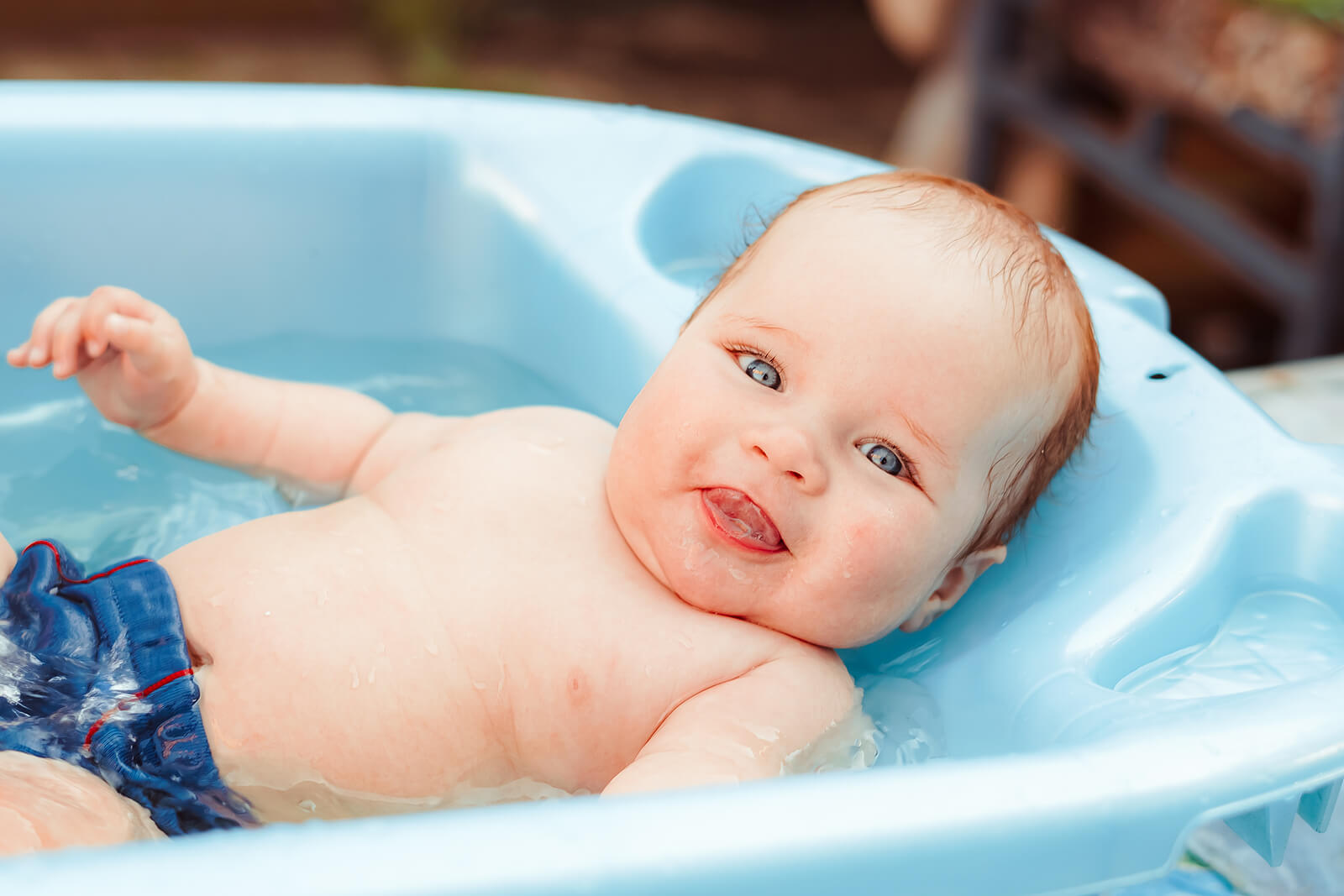5 Exercises to Strengthen Your Baby's Legs


Written and verified by the physiotherapist Maria Elisa Lisotti Luppi
Physical activity is one of the means to acquire or maintain healthy habits. Exercising with your baby at home can become a moment of stimulation, connection, and enjoyment with their mother or father. There’s no need to schedule a day and time–exercises to strengthen your baby’s legs can be included in everyday life.
Respecting the biological development of the infant is of utmost importance, without forcing postures that they haven’t yet acquired on their own. Every activity to be performed or stimulated should always be based on what the baby has achieved spontaneously. Spaces, games, and toys should be adapted to their evolutionary stage.
Doing exercises with your baby to strengthen their legs, as well as all activities that involve body movements performed with the child’s full freedom favor their body scheme. This refers to the notion of one’s own body and the movements performed with it.
Exercises to strengthen your baby’s legs according to their achievements

A child’s ability to learn and coordinate movements and then make them more complex is perfected over time. First, they learn to move and control their body parts with some rudimentary movements. Later, they manage to hold an object and then manipulate it with greater dexterity. Then, they manage to sit, then stand, until they’re finally able to walk without help.
Here are some exercises to strengthen your baby’s legs.
1. In the first months
One option is to take advantage of the time you spend changing diapers or clothes, while your child’s lying on their back. Gently take the baby’s legs from the ankles and accompany them with movements in all directions. Bend and stretch the legs, as well as open and close them with caution.
Always respect the limits of the joints. To perceive these limits, you need to perform the movements slowly, as well as be perceptive and aware of the contact with the child.
2. Once your baby’s able to sit up on their own
On a cushioned surface, place a toy of your baby’s choice in front of them to encourage them to reach for it. If needed, you can assist them to achieve the 4-legged position, which will help them move if they’re not yet crawling. If they already do, this stimulates them even more.
It’s important that the space is uncluttered, with clear visual information. Cluttered play areas confuse the baby’s stimuli.
3. When your baby can stand up with or without help
On a low chair or table to which the baby has access, place a toy that attracts their attention; this will encourage them to stand up. Once they’re standing, bring the toy to the floor next to them so that they can reach down and allow them to explore the object. Showing the child the gesture of standing up and sitting down will also help them imitate the movement.
You can also encourage them to push a chair or a light object, which will serve as a support for their first steps.
4. When your baby’s able to take their first steps
Place two chairs a few inches apart and help your baby stand up by holding onto one of them. Place the child’s favorite object on the other chair. In the beginning, the adult’s hand should be offered to the child to give them security and tranquility when making the steps to reach the other chair and reach the toy. Later on, the child will be able to do it with more independence.
5. Water exercises

Bath time is a good time to do some water exercises. In the first months of life, it’s important to hold the baby so that the water stays under their armpits. From that moment on, you can start massaging the baby in the water on a daily basis. They’ll last for short periods of time, respecting the infant’s reactions.
If they still don’t kick on their own, you can take their legs and assist them in kicking. If they already succeed, they’ll be motivated to do it. Exercises can also be done in a pool, with or without elements. One option is to hold the baby with a tubular or circular floaty and make small jumps. The adult should hold them with their hands in front and behind the trunk.
It’s more fun while playing
Exercises to strengthen your baby’s legs are best applied through play. This provides a pleasant stimulus and encourages the little one to connect more with the activity. The benefits aren’t only in their physical aspects, but also improve their emotional and cognitive development.
There are many proposals for activities with babies, both in the legs and the rest of the body. You should always offer the child the possibility of free movement, respecting their individual development, with love and patience, and always maintaining clear and simple communication in each exercise that’s proposed.
Physical activity is one of the means to acquire or maintain healthy habits. Exercising with your baby at home can become a moment of stimulation, connection, and enjoyment with their mother or father. There’s no need to schedule a day and time–exercises to strengthen your baby’s legs can be included in everyday life.
Respecting the biological development of the infant is of utmost importance, without forcing postures that they haven’t yet acquired on their own. Every activity to be performed or stimulated should always be based on what the baby has achieved spontaneously. Spaces, games, and toys should be adapted to their evolutionary stage.
Doing exercises with your baby to strengthen their legs, as well as all activities that involve body movements performed with the child’s full freedom favor their body scheme. This refers to the notion of one’s own body and the movements performed with it.
Exercises to strengthen your baby’s legs according to their achievements

A child’s ability to learn and coordinate movements and then make them more complex is perfected over time. First, they learn to move and control their body parts with some rudimentary movements. Later, they manage to hold an object and then manipulate it with greater dexterity. Then, they manage to sit, then stand, until they’re finally able to walk without help.
Here are some exercises to strengthen your baby’s legs.
1. In the first months
One option is to take advantage of the time you spend changing diapers or clothes, while your child’s lying on their back. Gently take the baby’s legs from the ankles and accompany them with movements in all directions. Bend and stretch the legs, as well as open and close them with caution.
Always respect the limits of the joints. To perceive these limits, you need to perform the movements slowly, as well as be perceptive and aware of the contact with the child.
2. Once your baby’s able to sit up on their own
On a cushioned surface, place a toy of your baby’s choice in front of them to encourage them to reach for it. If needed, you can assist them to achieve the 4-legged position, which will help them move if they’re not yet crawling. If they already do, this stimulates them even more.
It’s important that the space is uncluttered, with clear visual information. Cluttered play areas confuse the baby’s stimuli.
3. When your baby can stand up with or without help
On a low chair or table to which the baby has access, place a toy that attracts their attention; this will encourage them to stand up. Once they’re standing, bring the toy to the floor next to them so that they can reach down and allow them to explore the object. Showing the child the gesture of standing up and sitting down will also help them imitate the movement.
You can also encourage them to push a chair or a light object, which will serve as a support for their first steps.
4. When your baby’s able to take their first steps
Place two chairs a few inches apart and help your baby stand up by holding onto one of them. Place the child’s favorite object on the other chair. In the beginning, the adult’s hand should be offered to the child to give them security and tranquility when making the steps to reach the other chair and reach the toy. Later on, the child will be able to do it with more independence.
5. Water exercises

Bath time is a good time to do some water exercises. In the first months of life, it’s important to hold the baby so that the water stays under their armpits. From that moment on, you can start massaging the baby in the water on a daily basis. They’ll last for short periods of time, respecting the infant’s reactions.
If they still don’t kick on their own, you can take their legs and assist them in kicking. If they already succeed, they’ll be motivated to do it. Exercises can also be done in a pool, with or without elements. One option is to hold the baby with a tubular or circular floaty and make small jumps. The adult should hold them with their hands in front and behind the trunk.
It’s more fun while playing
Exercises to strengthen your baby’s legs are best applied through play. This provides a pleasant stimulus and encourages the little one to connect more with the activity. The benefits aren’t only in their physical aspects, but also improve their emotional and cognitive development.
There are many proposals for activities with babies, both in the legs and the rest of the body. You should always offer the child the possibility of free movement, respecting their individual development, with love and patience, and always maintaining clear and simple communication in each exercise that’s proposed.
All cited sources were thoroughly reviewed by our team to ensure their quality, reliability, currency, and validity. The bibliography of this article was considered reliable and of academic or scientific accuracy.
- LÓPEZ DELGADO, LUIS ALEJANDRO. EJERCICIOS FÍSICOS PARA EL FORTALECIMIENTO DEL CONTROL DE LOS SEGMENTOS CORPORALES EN LOS NIÑOS DE 0 A 2 AÑOS DEL SUB-CENTRO MONTECRISTI 2018. Diss. 2018.
- López Villacis, Mario Humberto. El AQUAGYM en el fortalecimiento muscular de los estudiantes del tercer semestre, carrera de cultura física de la Universidad Técnica de Ambato. BS thesis. Universidad Técnica de Ambato. Facultad de Ciencias Humanas y de la Educación. Carrera de Cultura Física, 2017.
- García, J. Latorre, et al. “Actividad física en el agua para mejorar la psicomotricidad de los bebés sanos. Protocolo del estudio Babyswimming.” Journal of Negative and No Positive Results: JONNPR 2.5 (2017): 186-193.
- Quiñonez Iturburo, Emanuel David. Ejercicios lúdicos para la estimulación temprana en niños menores 3 años. BS thesis. Universidad de Guayaquil, Facultad de Educación Física, Deportes y Recreación, 2019.
- Ojeda Alberca, Estela. “El gateo en el desarrollo cognitivo en niños menores de 2 años.” (2018).
- Ramos Vargas, Andrea Margarita. “Actividades lúdico-pedagógicas para fortalecer el desarrollo de la motricidad en niños y niñas de transición.”
This text is provided for informational purposes only and does not replace consultation with a professional. If in doubt, consult your specialist.








